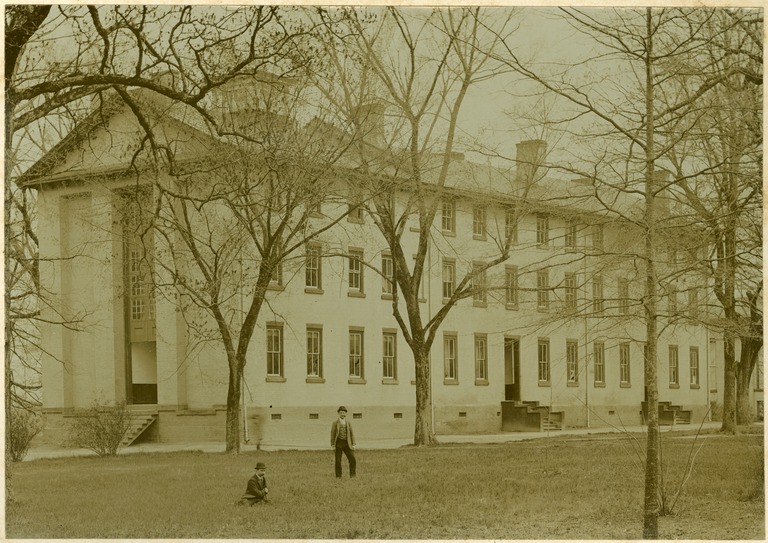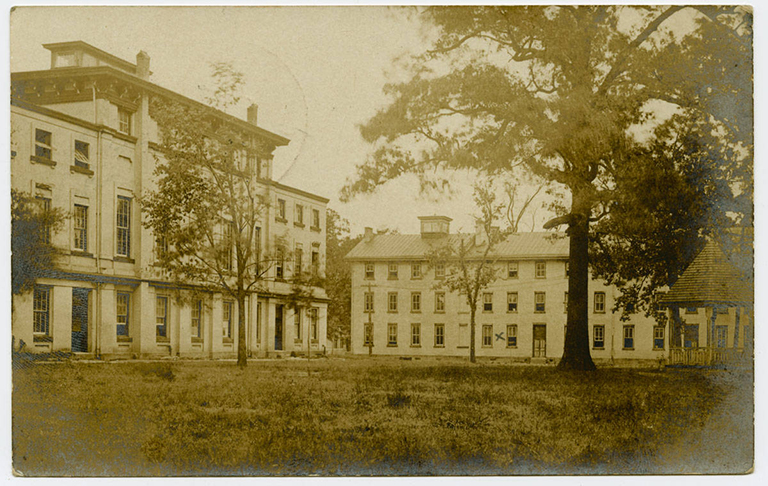Waitt, Kendall B. (1811-1893)
Variant Name(s):
Kendall Bailey Waite
Birthplace:
Massachusetts, USA
Residences:
- Chapel Hill, North Carolina
- Raleigh, North Carolina
Trades:
- Carpenter/Joiner
NC Work Locations:
Building Types:
Styles & Forms:
Italianate
Kendall B. Waitt (Waite) (September 13, 1811-December 10, 1893), a carpenter and cabinetmaker active in Chapel Hill, was a native of Massachusetts who worked on building projects at the University of North Carolina, most notably as contractor with Isaac J. Collier to build the additions designed by Alexander Jackson Davis for Old East and Old West. When Davis’s friend and patron Robert Donaldson advised Davis to take into consideration the local materials and workmen in planning buildings for the university, he had in mind such men as Waitt and Collier.
Little is known of Waitt’s early life or why he moved to Chapel Hill. According to one genealogical source, he was the son of Darius and Nancy Bailey Waitt of Massachusetts. He married Emily Hodgkins from Maine, and they had nine children. By 1836 Waitt opened a carpentry and cabinetmaking shop with Isaac J. Collier in the village of Chapel Hill. In 1843 Waitt sold his residence (which he had probably built) to Judge William H. Battle, who had it rebuilt or extensively remodeled by John Berry and others to create the house called Senlac, which still stands in Chapel Hill. In February 1844, Waitt took as a carpenter’s apprentice ten year old Pleasant Davis.
In December of 1844, Waitt and Collier took the contract for the additions to Old East and Old West at the University of North Carolina, to be built from designs by architect Alexander Jackson Davis. Given their limited previous experience, it is not certain how the two men won the contract. They subcontracted the masonry work to Raleigh contractor Dabney Cosby and hired Raleigh carpenter F. L. Walthall to supplement their carpentry work force. The project, involving the unfamiliar triangle of architect, client, and (multiple) builders involved considerable discussion over its execution, but it was eventually completed satisfactorily.
Waitt evidently settled in as university carpenter. University records from the 1840s to the Civil War show him building classroom benches, erecting outbuildings, and repairing university buildings and the homes of professors. Kemp P. Battle, who was a young man in Chapel Hill before the war and university president later in the 19th century, recalled Waitt as “a Northern man with the usual Yankee ingenuity and industry,” and as a “Jack of all trades. . . . skillful in all kinds of carpenter’s work, from building a house to making a coffin. He could do good work in a blacksmith’s shop. He was sometimes paid with a salary, about $500, but usually his remuneration was according to work done.” Waitt’s carpentry shop stood on the university campus near the present site of Phillips Hall. Waitt also continued working for Chapel Hill residents. Lucy Battle, reported to her husband, Judge William H. Battle on July 1, 1846, that their slave Louisa had died and that “Mr. Waitt made the coffin, carried it to the grave, and attended to the interment.” By the time of the Civil War, Waitt was living in a house on Franklin Street in Chapel Hill across the street from the Chapel of the Cross. In 1865, according to local tradition, his home was used as headquarters of General Joe Wheeler.
In 1866 Waitt and his family moved to Raleigh, where he advertised as an undertaker and cabinetmaker with a shop on Salisbury Street. He remained in Raleigh, where he was listed as a carpenter in 1870 and a cabinetmaker in 1880; in the latter year he and Emily were living with their son, Darius S. Waitt, a merchant. Waitt died in Danville, Virginia, and was interred at Oakwood Cemetery in Raleigh, where his wife and at least one son were also burried.
- Battle Family Papers, Southern Historical Collection, Wilson Library, University of North Carolina at Chapel Hill, Chapel Hill, North Carolina.
- Kemp Plummer Battle, History of the University of North Carolina From Its Beginning to the Death of President Swain, 1789-1868 (1907).
- Branson and Farrar’s North Carolina Business Directory for 1866-67 (1866).
- M. Ruth Little, The Town and Gown Architecture of Chapel Hill, North Carolina, 1795-1975 (2006).
- Orange County Records (Court Minutes, Deeds), North Carolina State Archives, Raleigh, North Carolina.
- University of North Carolina Board of Trustees Minutes, Dec. 23, 1844, 6, University Archives, University of North Carolina at Chapel Hill, Chapel Hill, North Carolina.
- James Vickers, Chapel Hill: An Illustrated History (1985).
Old East
Contributors:Albert and Osborne, plasterers (1844-1848); Atwood and Nash, architects and engineers (1924); Thomas C. Atwood, engineer (1924); Isaac J. Collier, contractor (1844-1848); Dabney Cosby, brick contractor (1844-1848); Alexander Jackson Davis, architect (1844-1848); Thomas Day, cabinetmaker (1844-1848); Arthur C. Nash, architect (1924); William Nichols, architect (1822); James Patterson, builder (1793-1795); Kendall B. Waitt, contractor (1844-1848)Dates:1793-1795; 1822 [addition]; 1844-1848 [addition]; 1924 [internally reconstructed]; 1991-1992 [extensive renovation]
Location:Chapel Hill, Orange CountyStreet Address:University of North Carolina, Chapel Hill, NC
Status:Standing
Type:Educational
Images Published In:John V. Allcott, The Campus at Chapel Hill: Two Hundred Years of Architecture (1986).
Catherine W. Bishir, North Carolina Architecture (1990).
Catherine W. Bishir and Michael T. Southern, A Guide to the Historic Architecture of Piedmont North Carolina (2003).
Edward T. Davis and John L. Sanders, A Romantic Architect in Antebellum North Carolina: The Works of Alexander Jackson Davis (2000).
M. Ruth Little, The Town and Gown Architecture of Chapel Hill, North Carolina, 1795-1975 (2006).
William S. Powell, The First State University: A Pictorial History of the University of North Carolina (1992).Note:Old East is the oldest building on UNC campus. It was enlarged and given the Tuscan end bay by Alexander Jackson Davis. See North Carolina Architecture and Architects and Builders in North Carolina for details and J. Marshall Bullock, “The Enterprising Contractor, Mr. Cosby,” for a detailed account of Dabney Cosby’s involvement in the Old East and Old West projects. As documented in extensive correspondence, Thomas Day planned and produced the interior woodwork, seating, etc. for the library and debating hall in Old East. Nothing is known to survive of his work there. The building was gutted and rebuilt within the old walls in 1924.
Old West
Contributors:Albert and Osborne, plasterers (1844-1848); Atwood and Nash, architects and engineers (1924); Thomas C. Atwood, engineer (1924); Isaac J. Collier, contractor (1844-1848); Dabney Cosby, brick contractor (1844-1848); Alexander Jackson Davis, architect (1844-1848); Thomas Day, cabinetmaker (1844-1848); Arthur C. Nash, architect (1924); William Nichols, architect (1822-1823); Kendall B. Waitt, contractor (1844-1848)Dates:1822-1823; 1844-1848 [addition]; 1924 [renovation]; 1991-1992 [extensive renovation]
Location:Chapel Hill, Orange CountyStreet Address:University of North Carolina, Chapel Hill, NC
Status:Standing
Type:Educational
Images Published In:John V. Allcott, The Campus at Chapel Hill: Two Hundred Years of Architecture (1986).
Catherine W. Bishir, North Carolina Architecture (1990).
Catherine W. Bishir and Michael T. Southern, A Guide to the Historic Architecture of Piedmont North Carolina (2003).
Edward T. Davis and John L. Sanders, A Romantic Architect in Antebellum North Carolina: The Works of Alexander Jackson Davis (2000).
M. Ruth Little, The Town and Gown Architecture of Chapel Hill, North Carolina, 1795-1975 (2006).
William S. Powell, The First State University: A Pictorial History of the University of North Carolina (1992).Note:Alexander Jackson Davis enlarged and remade the north façades of Old East and Old West with Tuscan end bays to face Franklin Street. Builder Dabney Cosby questioned his design. As documented in extensive correspondence, Thomas Day planned and produced the interior woodwork, seating, etc. for the library and debating hall in Old West. Nothing is known to survive of his work there. See J. Marshall Bullock, “The Enterprising Contractor, Mr. Cosby,” for a detailed account of Cosby’s involvement in the Old East and Old West projects. The photograph shows Old West on the right.


